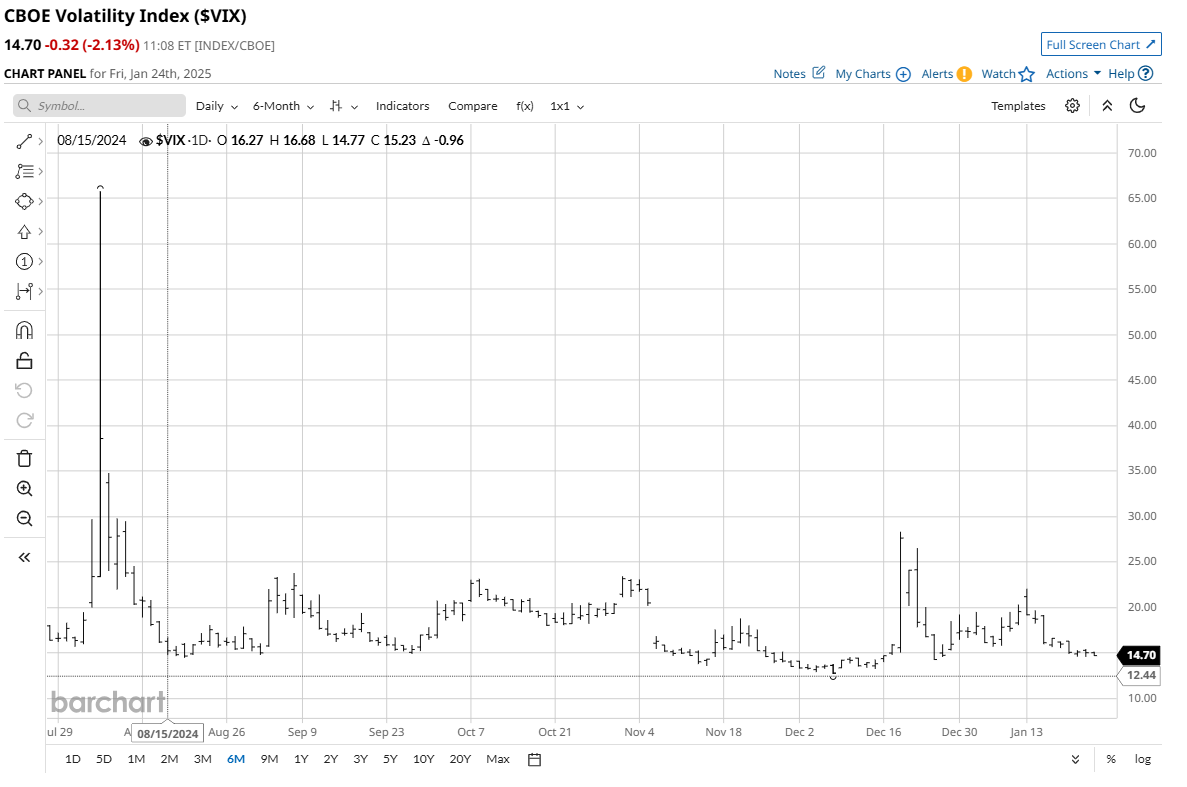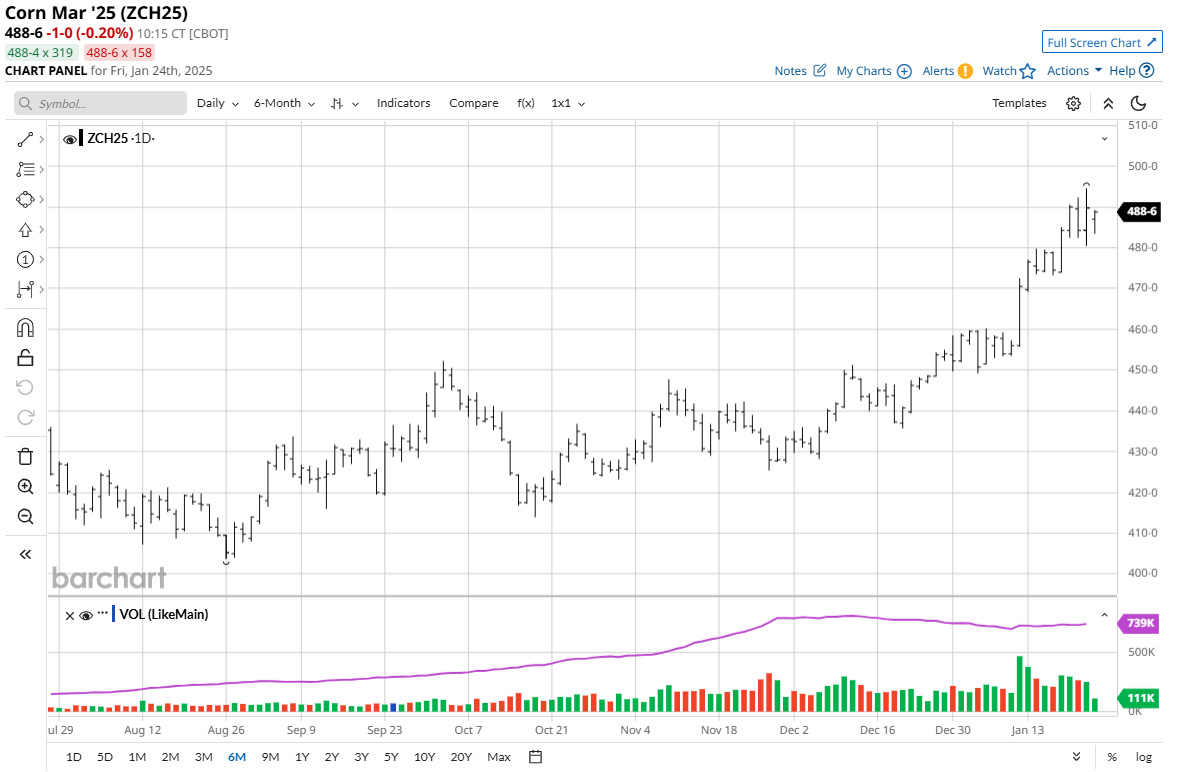
There’s a new sheriff in town. President Donald Trump’s administration is quickly falling into place and has already made major changes to U.S. government policies. Look for potentially higher daily price volatility in agricultural futures markets in the near term as new and sometimes disruptive policies are unveiled by the Trump administration.
How to Determine If Markets Are Becoming More Volatile
One way to gauge whether daily market volatility is on the rise would be to monitor the U.S. stock market’s volatility index (VIX). The VIX is the ticker symbol and the popular name for the Chicago Board Options Exchange’s (CBOE) Volatility Index ($VIX) — a popular measure of the stock market’s expectation of volatility based on S&P 500 Index ($SPX) options. If the U.S. stock indices are more volatile day to day, then it’s likely other markets are, too, including grains and livestock futures.

Trump: The Self-Proclaimed “Tariff Man”
Grain markets traders are monitoring Trump’s trade tariff intentions very carefully — especially regarding China. New tariffs against U.S. trading partners would be a bearish omen for grain markets that have just started to pull out of their months-long price slumps.

In his first week in office, Trump discussed a 10% punitive duty on China in retaliation he said for China sending fentanyl to the U.S. via Mexico and Canada. Separately, he said that the European Union has troubling trade surpluses with the U.S. Then, later in the week Trump backed off a bit by saying he’d “rather not” use tariffs against China. That followed his comments regarding his desire for broader duties, including a Feb. 1 deadline for 25% tariffs against Canada and Mexico, as well as duties on the EU. Meantime, China said it is willing to maintain communication with the U.S. to “properly handle differences and expand mutually beneficial cooperation.” The bottom line on this matter is that there is still keen uncertainty regarding just what the U.S. will do with its foreign trade policy. Keen uncertainty in markets breeds higher volatility.
Most grain market analysts agree the soybean (ZSH25) market may be most vulnerable to any new U.S. trade tariffs on China, given that China is a voracious consumer of soybeans, most of which come from South America and the U.S. In retaliation to new U.S. tariffs, China may curtail its purchases of U.S. ag products, when at all possible.

Foreign Exchange Market Closely Watching New U.S. Government Policies, Rhetoric
The currency futures/FOREX markets may be the most susceptible to higher price volatility in the coming weeks. New tariffs and Trump’s recent comments on currency market manipulation could have big implications on the foreign exchange market, especially the value of the U.S. dollar. The U.S. Dollar Index (DXH25) had rallied in recent weeks on the idea that the Trump administration would be more aggressive on implementing new tariffs as soon as he was sworn into office. The Dollar Index backed down last week on the less-aggressive tone on trade coming from the Trump administration following his inauguration. An appreciating U.S. dollar on the foreign exchange market is a bearish element for U.S. grain and livestock markets, as it makes U.S. products more expensive to purchase in non-U.S. currency.
Other Outside Markets’ Impacts on Grains and Livestock Markets.
U.S. stock market bulls should be fired up with the new Trump administration and its pro-business policies, including the “drill baby drill” mantra espoused by Trump in his inaugural speech. A rallying U.S. stock market is bullish for grain and livestock markets, suggesting better consumer confidence, rising incomes, and in turn, better demand for ag products. However, beware that the U.S. stock market’s rally after Trump’s election victory in early November may have already factored into equities’ prices the new pro-business Trump administration.
Safe-haven markets bulls are likely to benefit in the near term from the uncertainty regarding what actions the new Trump administration may take, and when. Those markets include gold (GCG25), silver (SIH25) and U.S. Treasurys (ZBH25). The U.S. dollar is usually a safe-haven asset during especially uncertain times. However, so far, the greenback has depreciated in the foreign exchange market as Trump’s administration is taking a more measured approach to implementing new trade tariffs. The modestly higher risk aversion in the general marketplace at present is a negative element for the grain markets.
How to Play the Increased Potential for Higher Near-Term Price Volatility
There are a couple ways a trader could play any higher price volatility in ag futures and/or other markets that may occur in the coming weeks. Conservative traders could just lighten up or exit their existing positions, waiting a few weeks for any potential higher price volatility to die down as the Trump administration settles in.
More aggressive traders could try to determine what markets might be impacted by Trump administration actions and then purchase cheaper out-of-the-money options, expecting a bigger price move in the direction the trader anticipated for that market.







